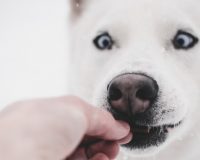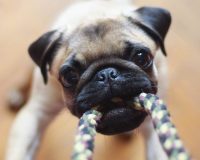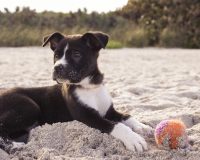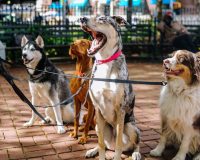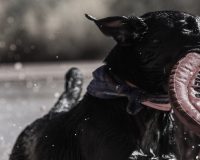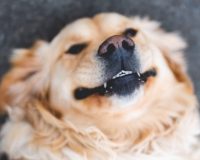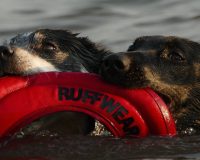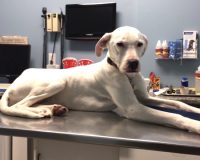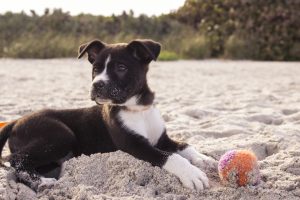
Enrichment: The Road to Rome
By CDWA | Sentience | Dogs 101 | November 23, 2020
Enrichment is a favourite to industry professionals. It is the set of stimulating activities we do to meet the needs of dogs—needs that their behaviours cue to us. The more hard wired the behaviour, the more necessary it is to satisfy it. Left to their own devices, pups will find a way to meet their own needs, but this usually means sacrificing some valuables. This, we avoid with enrichment, which also helps to train, and so much more.
By bringing dogs into our homes, we invite a species that has very niche, species-appropriate needs. We give a quality of life that they would happily reject: they might receive food and love from humans, but they also get boring in spades. This is why enrichment is so necessary.
The things we avoid with regular enrichment: chewing, destruction, waywardness—behaviours that arise from the frustration that builds from boredom—and getting mad at the dog, which takes a toll on both parties and the relationship.
The things we gain from regular enrichment: everything! Dogs who are better stimulated, trained and behaved, overall, and who are far more connected to their people. This dynamic brings unending fruit. Parents are happier and more patched in; inter-species understanding, trust and reliance is greatly enhanced, which increases engagement and joy. Both pup and parent get substantively more from the relationship, seemingly without any limit to other rewards that ripple out from there.
The things we gain from regular enrichment: dogs who are better stimulated, trained and behaved, overall, and who are far more connected to their people. This dynamic brings unending fruit.
We must mention context at this point. The history, health, emotional status and breed attributes play into how we satisfy needs through enrichment. Some examples:
• A rescued stray may see other dogs as competitors and not as play-mates, so socialized play may not be realistic…yet or ever. Still, we satisfy other needs with enrichment and train sociability as best we can by reshaping/re-conditioning the pup’s response to others over time.
• A breed with high prey-drive may not be trustworthy around smaller pups, making socialized play (ie: leash-free) dangerous. We might instead default to carefully supervised buddy play in a back yard and to satisfy prey drive with enrichment that reinforces boundaries, fairly heavily. In this case, enrichment doubles up as training.
One needs context and insight into these factors, along with a particular pup’s breed attributes, in order to apply customized enrichment strategies with a degree of sensitivity to the nature of the dog one parents. For guidance, a Certified Trainer can help.
For the purpose of this article, we’ll take a general approach and discuss the fairly universal needs and enrichment tips for each.
Connecting the dots: what are a dog’s needs and how do I meet them.
First and foremost, socialization with other dogs, exercise and challenging, stimulating activities for the senses and mind that satisfy the most hard wired needs are what Parents will want to focus on with some priority. Also give plenty of priority to breed requirements: retrievers, hunters, athletes, and so on. The American Kennel Club has good information on breed genetics and much to offer that characterizes the genetic needs of each.
Socialized Play with Dogs and Humans
Dogs are social beings, making socialization with other dogs a strongly hard wired need, best started in early puppy hood when they are learning. Play is incredibly instructive and pleasurable and the exercise produces feel-good endorphins. Play is so important because it builds experienced diplomats: highly social and reliable, secure, healthy dogs in the long term. Ones that can be dressed up and taken anywhere!
Dogs learn from dogs incredibly well. They acquire the keys to a life well lived. It’s advisable to expose your dog to well trained ones, for best results.
Play, as a tool for instruction, helps pups learn nuance—the skill of reading life and responding properly. For instance, the bite pressure applied in play is soft, whereas the bite pressure in a pup who never learned through play can be indiscriminately hard.
For those pups who like to play and play well, rough play between dogs is generally good, so long as each dog is engaged in true, healthy play. It polishes physical, agility and strategic skills and is, most importantly, stimulating and exceedingly fun.
Human-to-dog play should not be as rough so that the pup learns to be gentle with humans. Human-to-dog play should also be play, not overwhelming or frustrating to the dog, or mean-spirited.
Dogs who are denied the opportunity to play early in life grow to be tense/anxious around others, asocial or anti-social. They cannot read other dogs well and are more inclined to experience fear, leading to reactivity, such as fight, flight and barking.
Dogs learn from dogs incredibly well. They acquire the keys to live a life well lived. It’s advisable to expose your dog to well-trained ones, and to keep all social experiences positive, for best results.
Tug of War is, bar none, an extremely pleasurable activity for pups to satisfy ‘grab and hold’. This is a more complex game, however, that requires training and boundary-setting.
Predatory Sequence Needs
Arguably, some the most hard wired needs are those seen in the predatory sequence, or the hunt: search, stalk, chase, grab, hold, dissect and chew/eat.
The Search & Stalk Need
Recommended enrichment for the search and stalk need include hide and seek, or hunting for things the pup values highly, using their noses. The valuables could be family members, treats or prized toys. Simply hide the valuables away from the pup’s view and set him off on a mission, using the “find it” or “where’s X” cue. The pay off for finding X must motivate the dog to search for it, so treat, praise and love the pup when he does.
Start simple so the puppy learns the game and, to keep it interesting over time, increase the level of challenge and reward. Celebrate bigger as you increase the levels to reinforce the positive behaviour of searching for treasures you hide. Hide and seek of toys, treats or even portions of breakfast is great to do when leaving for work as well—it gives the pup a rewarding project, making your leaving not as difficult.
The Chase Need
If the pup loves balls and retrieving, hide balls and reward with a few throws, along with treats and celebration. A few throws of any favourite toy achieves the same. This satisfies the chase need, which is why we consider it enrichment.
Grab & Hold
Tug of War is, bar none, an extremely pleasurable activity for pups to satisfy grab and hold. This is a more complex game, however, that requires training and boundary-setting. In a nutshell, parents don’t want to reinforce tug of war without “release” cue training because the tug toy can be a leather shoe or some other inappropriate item.
See our Sentience article on Tug of War for more detail on how to properly train the game.
Chew & Dissect
Wrapping a stuffed bone, high value treats or food, or a stuffed, frozen Kong into layers of knotted, clean rags is amazing enrichment. The more challenging you make this, the longer the project and the more physical and mental power the pup exerts to get to the reward. Name this project as, say, Prezzie, and cue the pup to “Find your Prezzie”. The more rags and knots you use, the greater the fun. Consider hiding it in an openable container of some sort, like a box, to up the ante. If you do, use stinky food in the rag assembly somewhere, like parmesean cheese shavings. The result? Total bliss and an amply stimulated, calm pup.
These are just a few of a hundred fantastic ideas out there that help Parents build happy and fulfilled dogs. For many more ideas, check out the Facebook group, Canine Enrichment Ideas.


